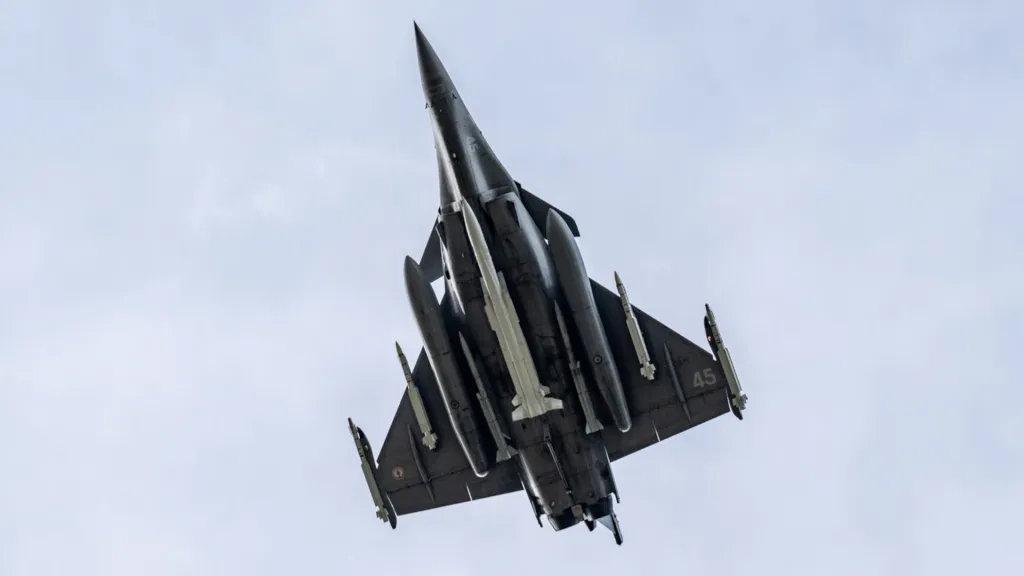French authorities have provided the first real look at the latest version of the Air-Sol Moyenne Portee (ASMP; or Medium-Range Air-to-Surface) ramjet-powered, nuclear-armed cruise missile. Officials in France have also confirmed that the ASMPA-Renove (ASMPA-R) variant is now in service with the country’s Navy.
A French Navy Rafale M fighter, belonging to the service’s Force Aeronavale Nucleaire (FANU), or Naval Nuclear Aviation Force, conducted a test launch of an ASMPA-R without a live warhead earlier today as part of what was dubbed Operation Diomede. The test involved “a flight representative of a nuclear raid,” according to a machine translation of a social media post from Catherine Vautrin, France’s Minister of the Armed Forces.
A separate statement from the Ministry of the Armed Forces of France says the ASMPA-R officially joined the FANU’s arsenal on November 10. The ASMPA-R has already been operational since 2023 with the Forces Aeriennes Strategiques (FAS), or Strategic Air Forces, part of the French Air and Space Force. Both services use Rafale variants as the launch platform for these missiles. French authorities did release pictures of an Air Force Rafale carrying an ASMPA-R last year, around the first known test launch of the missile. However, the weapon was entirely blurred out. A grainy image from the actual test was also released, but it was so low quality that there were no discernible details.
It is worth noting here that a portion of the French Navy’s Rafale M fleet has already had a nuclear mission with older ASMP-Ameliore (ASMP-A; ameliore translating into English as “improved”) missiles. France’s sole aircraft carrier, the Charles de Gaulle, is the only surface ship in NATO currently known to be capable of hosting nuclear weapons, but the ship does not conduct routine patrols with ASMP-series missiles onboard.
We can now see that the “renovated” ASMPA-R is externally very similar to the preceding ASMP-A. Both missiles notably feature a pair of air intakes along the middle of their bodies, which is part of the ramjet propulsion systems. As seen below, the tail fin configurations do appear to be different between the A and R models. The A model has smaller fins at the rear and larger ones just in front, while the R somewhat reverses that arrangement. The reason for this is unclear.
The ASMPA-R does reportedly have a greater range than the ASMP-A – 372 miles (600 kilometers) versus 310 miles (500 kilometers) – but both missiles are said to reach a peak speed of Mach 3.
There had been reports that the ASMPA-R features a new nuclear warhead, but some sources also say it is the same TNA design found on the ASMP-A variant. The TNA is a so-called ‘dial-a-yield’ design with reported yield settings ranging from a minimum of 100 kilotons to a maximum of 300 kilotons. It is possible that the TNA warheads in the R models have also been modernized as part of the upgrade process.
Otherwise, the ASMPA-R is generally described as a life-extension upgrade package for ASMP-A missiles, which first began to enter service in 2009. The ASMP-As replaced the original ASMPs, which had started entering service in 1986. The baseline ASMP had a maximum range of 186 miles (300 kilometers) and an older TN 81 warhead with the same reported range of yield settings as the newer TNA.
ASMP-series missiles fired from French Air Force and Navy Rafales make up the aerial leg of France’s current nuclear dyad. The missile’s combination of supersonic speed and standoff range is intended to help ensure the missiles successfully reach their targets, while also helping to keep the launch platforms further away from threats.
The development of the ASMPA-R, which dates back to the mid-2010s, is part of a larger ongoing effort to modernize France’s nuclear deterrent arsenal. This effort also includes the new M51.3 nuclear-armed submarine-launched ballistic missile, which officially entered service last month. M51-series missiles arm the French Navy’s Triomphant class nuclear ballistic missile submarines, forming the sea leg of the country’s nuclear dyad.
France is also working on a new air-launched cruise missile, the Air-Sol Nucléaire de 4ème Génération (ASN4G; or 4th Generation Air-to-Surface Nuclear), which is expected to be scramjet-powered, longer-ranged, and capable of reaching hypersonic speeds, typically defined as anything about Mach 5. Today’s statement from the French Ministry of Armed Forces also confirms that the goal is still for the ASN4G to begin entering service in the 2035 timeframe.
There have also been a number of significant developments regarding French nuclear deterrent policy, in general, this year. Reports in February said the French officials were eyeing forward-deploying nuclear-capable Rafales to Germany, citing concerns about the commitment of the United States to the NATO alliance. Within NATO, there are three nuclear powers, France, the United Kingdom, and the United States. Some non-nuclear member states are also party to agreements wherein they could gain access to U.S. nuclear gravity bombs in the event of a major crisis.
In March, French President Emmanuel Macron also announced that his country would establish a new nuclear-capable air base, the country’s fourth overall, which will host French Air Force Rafales. In July, France signed an agreement to formally coordinate its deterrence forces with those of the United Kingdom, as well.
There has been a certain new openness about nuclear weapons and deterrence within NATO, as a whole, in the past few years, which has come amid concerns about spillover from the conflict in Ukraine and general Russian aggression.
Regardless, France’s own nuclear modernization efforts are continuing apace, with French Navy Rafale Ms having now joined their French Air Force counterparts as launch platforms for the ASMPA-R cruise missile.
Contact the author: joe@twz.com
